LINK
50mm f/1.8D AF (1978-today)
Nikon's least expensive lens is also among its sharpest. It has no distortion, focuses almost instantly, and it's Nikon's smallest and lightest lens.
It is among Nikon's fastest lenses, and covers film and the full FX frame.
Except that the D40, D40x and D60 can't autofocus with it (neither can the F3), there is no reason not to own one of these, unless you opt for the twice as expensive 50mm f/1.4 D.
All the earlier 50mm f/1.8 lenses are also all excellent, including the 50mm f/1.8 AF (non-D), 50mm f/1.8 Nikkor manual focus, and the 50mm f/1.8 Series E.
Nikon 18-55mm DX (2006-today) top
Even as a cheap, plastic lens, the 18-55mm is sharp, sharp, sharp, and focuses so close that few people will need a dedicated macro lens.
Included as a kit lens with Nikon's cheapest cameras, lenses this good and this cheap ask us what would happen if Nikon put some of this same mojo into its more expensive lenses.
It only covers DX digital; it can't cover film or FX.
18-200mm VR DX (2005-today) top
The 18-200mm VR is the freedom lens. It is the lens which let me get rid of the old fashioned "camera bag" photographers used to have to carry.
The 18-200mm VR replaces all the lenses we used to haul around. The only thing it doesn't do is replace an ultra-wide lens like the 12-24mm DX, or allow us to shoot sports in dim light like the 70-200mm VR. If you need anything longer, you'll get better photos by getting closer with the 18-200 VR than you will by using a longer lens like the 600mm VR.
Back in the days of DX cameras, the 18-200mm let me just go and shoot, and not have to carry other lenses or have to change them in a middle of a shoot.
135mm f/2 DC AF (1990 - today) top
Americans just don't get this lens, because Nikon messed up its name. The 135mm DC, or "Defocus Control," lens, is among Nikon's sharpest lenses ever. Defocus control doesn't mean soft focus, it means "background softness control." The DC feature is really Bokeh optimization.
The DC feature always keeps the subject ultra sharp, and allows the photographer to defocus just the background (or foreground) into the softest, smoothest, dreamiest and creamiest pastels ever.
The 135mm DC is Nikon's best hand-held portrait lens ever, as well as a killer-sharp 135mm lens for everything.
14-24mm f/2.8 AF-S (2007-today) top
The big, heavy 14-24mm f/2.8 AF-S just rewrote the book on ultra-wideangle lens performance. It raises the performance bar about 20 years ahead of every other ultra-wideangle SLR lens.
The 14-24mm is sharp, sharp, sharp, even wide open, and even in the corners.
It's so good that people are buying special adapters just to use them on Canon cameras!
The 14-24mm is excellent on amateur DX cameras like the D300, but doesn't really start pumping until you use it on film or a full-frame FX digital camera.
I've shot a lot of fixed 24mm, 20mm, 18mm, 17mm, 15mm and 14mm lenses in my days, and this zoom smokes them all. It lets me do things I never could, like jump into a dark, abandoned building without a tripod, shoot away at f/2.8 and high ISOs on a D3, and get out with excellent photos for which I don't need to make any excuses.
85mm f/1.4 AI-s (1981-2006) top
The optics of most of Nikon's earlier AI-s manual focus lenses have been exceeded in Nikon's newer AF lenses. This isn't the case here.
This manual focus lens outperforms its newer 85mm f/1.4 D autofocus sibling. In fact, its so good that even after the f/1.4 autofocus lens came out, for about the about the same price, Nikon kept making these for 10 more years!
It's sharper than the new AF lens, and it has much better bokeh than most other Nikon lenses.
If I'm photographing moving people and kids, of course I'll prefer the AF lens, but if I'm hugging a tripod, the King is still the King.
28mm f/1.4D AF (1994-2006) top
Nikon 28mm f/1.4 D AF. (blacked-out for national security purposes)
Nikon was once great. Nikon spent ten years perfecting this masterpiece, then discontinued it in 2006 from lack of market interest. Collectors finally figured it out, and they sell used for double what they sold for new.
This lens is special because its sharp, even in the corners, even wide-open at f/1.4. It is worlds better than today's 35mm f/1.4 (which is a manual focus lens made since 1969) or the manual focus 28mm f/2.
This lens allowed me to shoot things hand-held on ISO 50 film that otherwise I could not.
Because it has half the focal length of a 50mm lens, it can be hand-held at for exposure times twice as long. This lets me shoot hand-held in light twice as dim as with a 50m f/1.4 lens, or in the same light as a 50mm f/1 lens.
Unlike a 50mm lens, it has far more depth of field at the same f/stop. This additional depth of field also contributes to sharp hand-held photos at night. This 28mm lens at f/1.4 has enough depth of field for most things, while 50mm f/1.4 lenses have paper-thin depths of field
With digital it's no longer as needed, since digital allows high ISOs that film could not. The rise of digital contributed to lack of interest in buying these 28mm f/1.4 lenses new.
70-180mm f/4.5-5.6D Micro (1997-2004) top
Nikon ED 70-180mm f/4.5-5.6 D AF Micro.
Another lens so great that the market never figured it out, this is the only true zoom Micro (macro) lens ever made by Nikon. It also sells used for more than it sold for when new.
Unless you're photographing stamps, which makes you silly because you'll get better images sticking them in a scanner, shooting macro is a real pain having to move in and out all the time to frame products and chasing moving subjects like poisonous snakes. I know snake guys who pack heat to protect their 70-180mm lenses; these lenses are that good and irreplaceable.
All of my recent product shots, like half the shots on this page, are shot with this lens.
13mm f/5.6 AI-s (1976 -1998) top
The 13mm f/5.6 was the world's widest lens when it was introduced, and is still the widest non-distorting professional SLR lens ever made in all of history.
It covers FX; a DX lens would need a focal length of just 8.5mm to cover the same ultra-ultra wide angle!
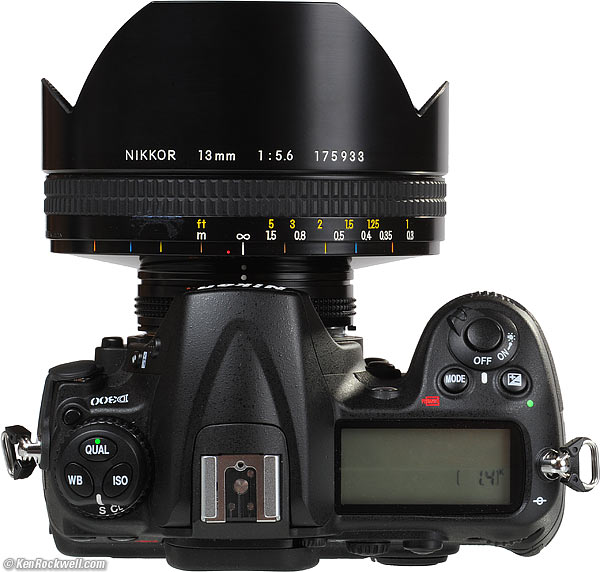
Nikon 13mm f/5.6 swallowing a D300.
This beast is big and heavy: 5 inches (12cm) around and it weighs 3 pounds (1.4kg) with caps.
The 13mm is not a fisheye. Straight lines stay straight. In fact, just to show off, the 13mm has less distortion than zooms or most other normal and wide lenses! Drop a ruler on lines in the image, and they're straight.
It was made back when Nikon was still great enough and crazy enough to make things just because they could. It always cost a significant fraction of what the average American family earns in a year, and used ones today sell for about the same real price as when new: about $5,000 to $20,000.
I lusted after the 13mm ever since I was a kid in the 1970s. I saw one on display at Nikon House in Rockefeller Center in New York City in the 1970s, and saw one again in early 2008, from which I'll be penning a review one of these days.
Nikon only made these to special order, and only made a few hundred of them across 20 years. Customers who took factory delivery in Japan were treated to a ceremony where the lens was blessed by a Shinto priest. I've only seen two in my life, both in captivity, and never seen one in the field.
Sigma makes an inexpensive 12-24mm zoom that may be wider, but it's not a professional lens, its not a Nikon lens, and it distorts slightly. Nikon's 14mm f/2.8 and 14-24mm AF-S are not quite as wide, and have more distortion.
THis 13mm is also unusual in that it has little to no distortion of straight lines. Unlike zooms and most fixed lenses like the current 14mm f/2.8 and 14-24mm AF-S, make a photo of the horizon along the bottom or shoot a brick wall, and everything stays straight and square. Of course even the slightest tilt on your part throws everything into a bizarre angular array of converging and diverging lines, but that's the fun.
Don't expect ever to see one of these, since production was so low. Just get the 14-24mm AF-S , which is a lot less expensive, two stops faster and a lot sharper.
28-80mm G (2001-2006) and 28-200mm G (2003-2006) top
Nikon 28-80mm G, in ghastly silver.
These are very inexpensive plastic-mount lenses that came out in 2001 and 2003 for sale with Nikon's cheapest film cameras like the N55 and N75. No one paid any attention, because everyone was swapping over to digital cameras faster than Nikon guessed, leaving Nikon stuck with pallets of unsold N75s.
These two lenses incorporate every trick Nikon has learned over decades and decades of lens design and volume manufacturing. Each uses aspherical elements to improve performance and reduce size and weight.
Both are sharp, even in the corners. Even the 28-80mm G is sharper than the far more expensive 24-120mm VR, which made my 10-Worst list.
Each of these lenses isn't quite as sharp as Nikon's best, but pretty darn close. What gets them on my Best list is that they are this good at such a low price, and that they are tiny and weigh nothing for easy carrying.
The 28-200mm G is a miracle. Not only is it pretty sharp in most cases, what gets it on my Best list is that it focuses so closely at every focal length. It focuses down to 17 inches (43cm) at every focal length, much closer than any other Nikon tele, ever. Most teles, like the 135mm DC, often can't focus closely enough for photos of baby heads. This 28-200mm does. The AF isn't that fast since it covers such a wide range, but its fast enough.
The 28-80mm G focuses more closely than other Nikon lenses, often eliminating the need for a macro lens. It autofocuses faster than any other Nikon AF lens, including the AF-S lenses. Just try one; it's uncanny how instantly and exactly it focuses.
If I want a "do everything" lens for my D3 or D700, it's not the 24-120mm VR. It's the plastic 28-200mm G.
80-200mm f/4.5n AI (1977-1981) top

Nikon Zoom-NIKKOR 80-200mm f/4.5n AI.
Selling today for $35 at garage sales, or not more than $199 at dealers, this unassuming tele zoom just happens to be the sharpest tele zoom I've ever tested. In my 105mm center, 200mm center, 105mm corner and 200mm corner sharpness comparisons, it's the most consistent performer.
All Nikon's 80-200mm f/4.5 zooms are excellent. I found the best is this AI "n" (new) version, which is recognized by the black rectangular plate on its rear mount.
The zoom and focus are supposed to be loose and slippery. This was the sports and action lens of its day. No one was silly enough to shoot zooms on tripods pointed down, so creep wasn't the issue.
This Nikkor lens was made with such incredible precision that it didn't need to be pumped full of grease to fill up the internal slop of cheaper lenses of its day. It is so well made that it works with little or any lubrication, so it can work in temperature extremes and needs only a tiny flick to move the settings. Notice how it moves so easily, but that there is no play in any of the movement.
NIKON WORST LENS
Nikon's 10 Worst Lenses topEven lenses that aren't very sharp can be used to make incredibly great photos. However, as lenses go, these are the pigs at Nikon's party.
Given any of these lenses I could go make images as good as any of my others. As lenses go, each of these isn't just me saying they are duds; for each one, plenty of others have confirmed my observations. These are all this bad.
43-86mm F (1963-1976)
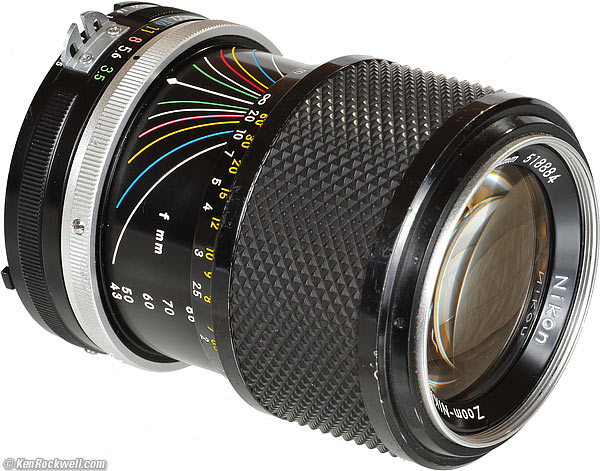
Nikon 43-86mm f/3.5 F.
The original Nikon 43-86mm is the worst lens Nikon has ever made.
It's worse than the worst, because not only is it terrible by itself, it was so awful that it has tainted the reputation of all other zoom lenses to this day.
What makes it so bad? It's Nikon's softest lens, and is loaded with untold levels of distortion. It also has awful flare and ghosts.
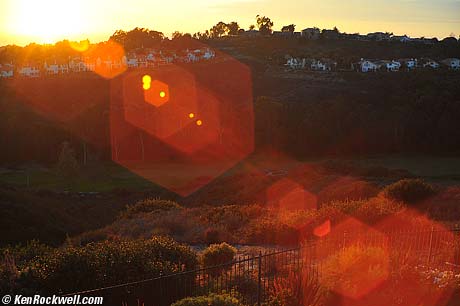
How bad it was! Ghosts everywhere!!! (D3, 43-86mm f/3.5 F at f/8)
When people say zooms aren't sharp, zooms flare, and zooms have a lot of distortion, it is because this horrible lens set these expectations.
The 43-86mm came in two versions. This first horrible version has the lettering inside the filter ring. The later version (1975-1982) is a completely different lens, and is just fine. It has its lettering outside the filter ring.
18mm f/2.8 D AF (1994-2006) top
This is Nikon's worst 18mm lens ever. The embarrassing part is that it cost $1,300 new (at full NYC discount), and still sells for about $800 used, and it's much worse than Nikon's older 18mm lenses.
It uses every trick Nikon knows, and is worse than earlier lenses!
The 18mm f/2.8 D AF uses internal focusing and aspheric elements, and somehow winds up being softer and having more distortion than Nikon's original 18mm f/4, 18mm f/3.5 AI-s, or their current zooms. It has a lot of falloff wide-open, too.
As we politely refer to a morbidly fat person as "having a slight weight problem," this 18mm lens has a slight ghosting problem. It has more ghosts than any other 18mm lens, and probably more ghosts than any other Nikon lens except the original 43-86mm above. I have no idea why it's so bad, but it is. This 18mm AF is one of the very few lenses for which I would use a hood. Good luck if you get stuck buying a used one without its original HB-8 hood; these hoods are now impossible to buy new or used.
The 18mm f/2.8 is a decent enough lens by itself. Since it's so expensive and even worse then the lenses it replaces, it earns itself the top position on my 10-worst list, just behind the hideous original 43-86mm.
300mm f/4.5 P (1964-1969) top
The 300mm f/4.5 P was Nikon's first 300mm SLR lens. It only had 5 elements (that's the "P," as in "penta"), and was loaded with color fringes.
Even on film, the results were always loaded with primary (red-blue) lateral color fringes on the sides of the picture. Stopping down made them worse, since as the lens sharpened up, the fringes became more visible.
In 1969 Nikon replaced this 300mm f/4.5 P lens with the excellent 300mm f/4.5 H. The H means 6 elements, as in "hex." Nikon made the excellent H version in various cosmetic variations though 1998.
24-120mm VR (2003-today) top
The 24-120mm VR is a failed dream because it's too darn soft. At 24mm, the corners on film and FX are soft. It's softer than any other Nikon lens I've tried at the wide end.
It's on my 10-worst list because it's new enough and made with enough technology that it ought to be fine. It's not, and Nikon's MTF curves show you that Nikon designed it this way.
This was the first lens I tried on my D3. Not only was it soft at the wide end, even stopped down, the corners got too darn dark from falloff at 120mm, where it's only f/5.6 wide-open.
35-70mm f/3.3-4.5 AI-s (1984-2005) top
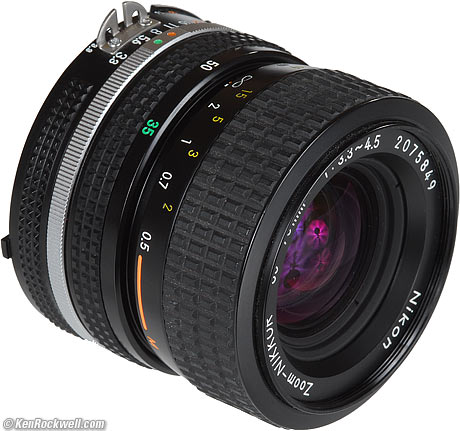
Nikon 35-70mm f/3.3-4.5 AI-s.
This is a cheap and crappy lens. Nikon has made other cheap lenses which make it to my 10-Best list that are great.
This lens simply isn't very sharp, and is unbecoming to Nikon's manual focus Nikkor lenses with its use of plastic. The focus, zoom and aperture rings are plastic, and even the silver grab ring may be plastic. It looks like a tough metal Nikkor, but it's not. I don't mind plastic if it's sharp like the Series E lenses, but this isn't a sharp lens. Its loaded with distortion, too.
The same optics appeared in an AF version in 1986. As an AF lens, the optics are sad, but the mechanics and usability are swell, so I wouldn't put it on my Worst list if it weren't for the dishonorable manual focus version above.

Nikon 35-70mm f/3.3-4.5 AF. (1986-1994)
Nikon also sells, even today, a 35-70mm f/3.5-4.8 manual focus lens sold with the FM-10. It doesn't make it to this list because it isn't even a Nikon lens. It's really a Cosina lens made by Cosina and branded Nikon.
Nikon 45mm f/2.8 P (2001-2006) top
The 45mm f/2.8 was introduced in 2001 as a vanity accessory along with the new Nikon FM3a manual-focus body.
It was very expensive, $450, and was claimed to have magical powers which imbued it with extraordinary optical performance. We rational types read Nikon's PR which said that it was just a primitive Tessar design.
The Tessar design, over 100 years old, was good in its day, but the Nikon 45mm P is far softer than the $120 made-in-China 50mm f/1.8 AF lens in my 10-Best list. Sure, this 45mm is small, but its performance is sucky (especially in the corners of FX) compared to every other current Nikon normal lens, and it costs far more. If you're just shooting DX, you aren't using the corners and it probably looks fine.
The P in this lens stands for "Program," as this manual-focus lens has electronic contacts to let it talk to the metering systems of digital and autofocus film Nikons. All cameras treat this lens as if it's an AF lens, except that it can't autofocus.
Needless to say, Nikon didn't fool anyone, and discontinued this lens with lots of stock on dealer's shelves in 2006. Its only purpose, other than as a tiny lens, is as a collectors item, since it was packaged as a couture item shipped with with color-coordinated caps, hood and a filter.
And just like couture items, it's a pain to use. Its so tiny that there is no room for a grip ring for mounting and unmounting, so you have to run the focus or aperture to one end before you get any traction to the mount. People whined about the thin plastic focus rings of Nikon's first AF lenses, but the 45mm P is the worst. Its focus ring is a cold, hard, miniscule metal ring, Nikon's worst ever. Even the scalloped rings of Nikon's first SLR lenses were far better, as were the wider rings on Nikon's 1940's rangefinder lenses.
It uses almost the same optics as Nikon's 45mm f/2.8 GN (1968-1977), which was Nikon's very least expensive lens in its day. I've compared them both on the D3, and they are both about the same. The older 45 GN additionally offered a superior 9-bladed (later 7-bladed) diaphragm, and a built-in analog computer that calculated flash exposure automatically as focused. This 45 P offers none of this. The 45 GN is a decent lens, but when you try to charge this much for the 45 P, it's on the bottom my suck list.
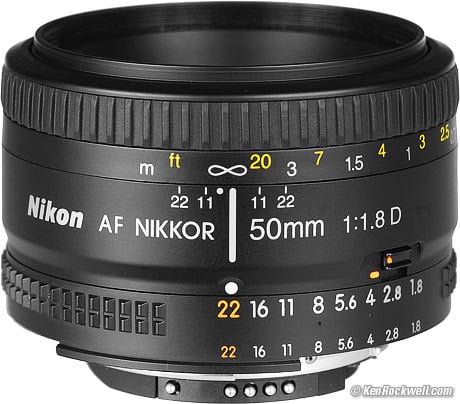
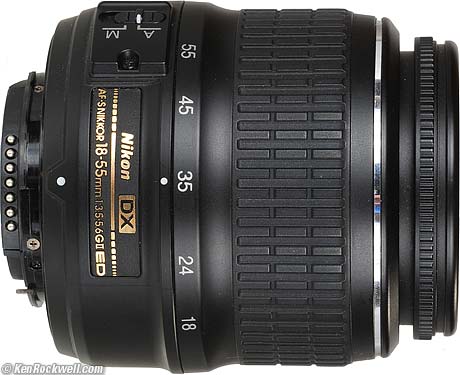
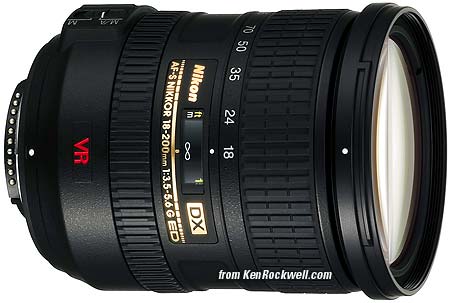


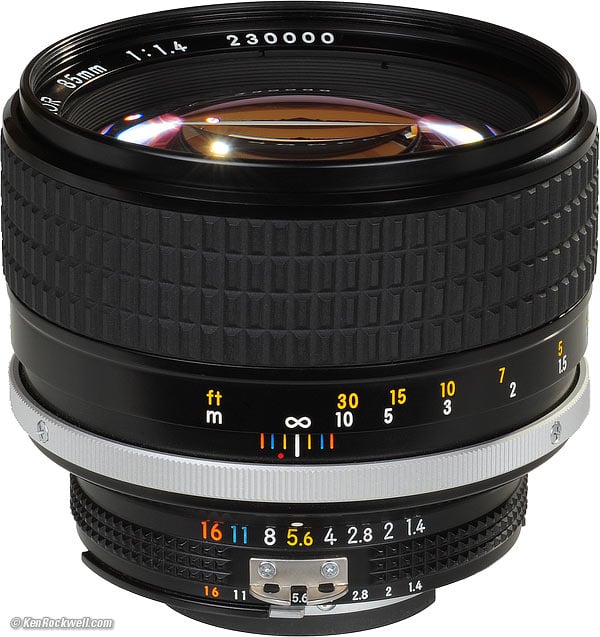
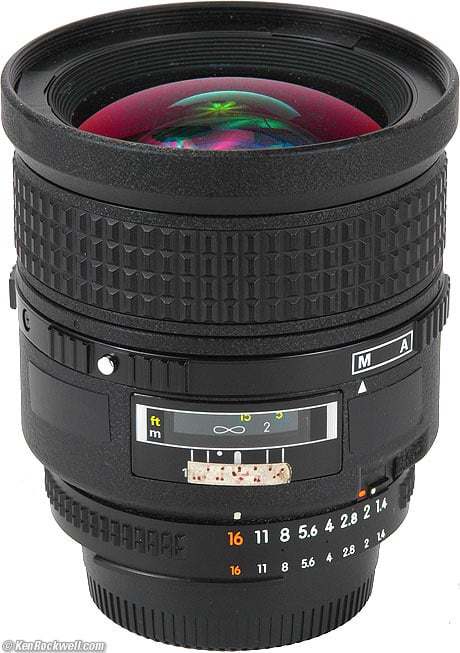
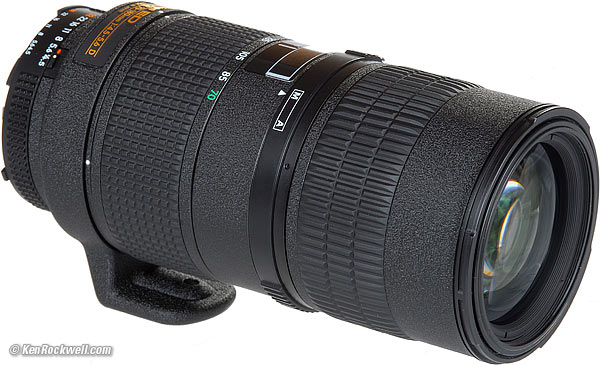
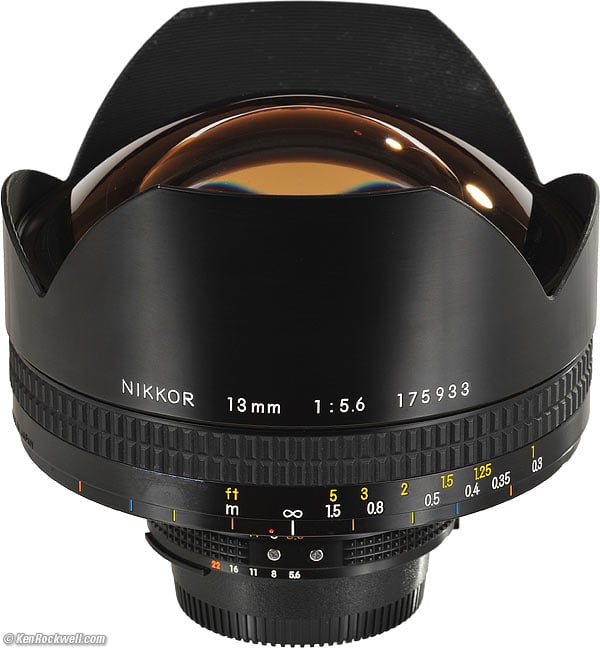
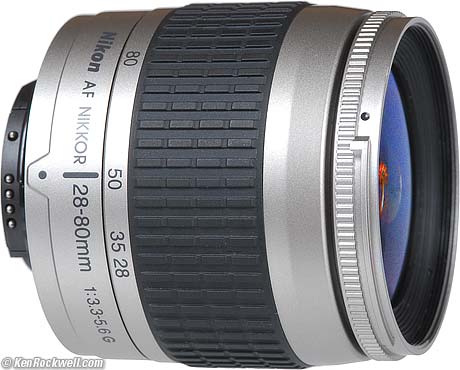
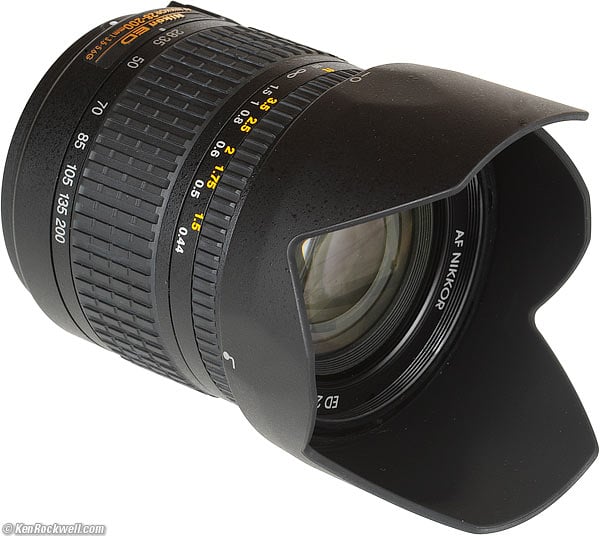
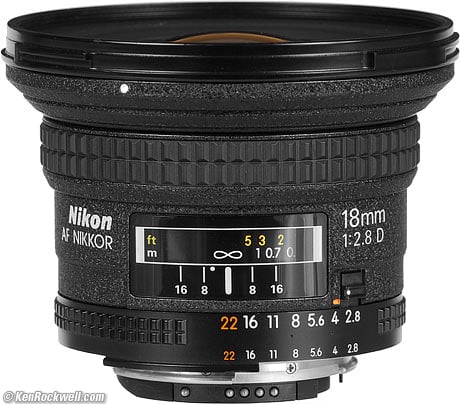
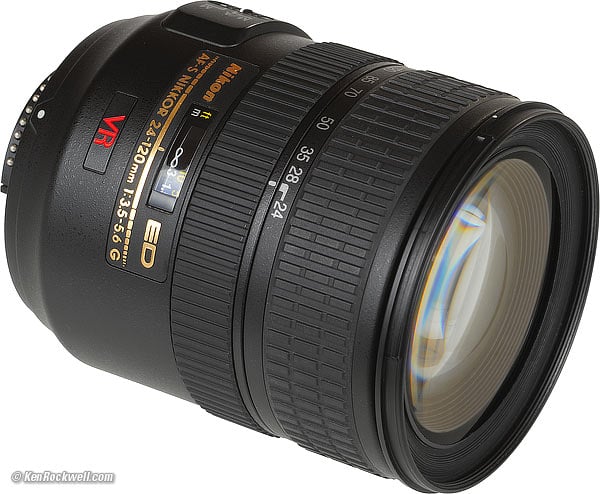
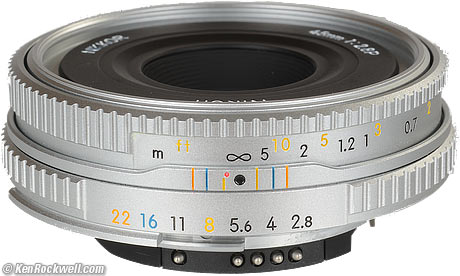

No comments:
Post a Comment